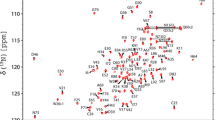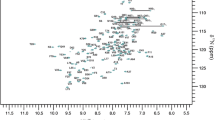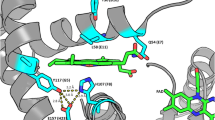Abstract
The cysteine-homologues of glutathione peroxidases in Trypanosoma brucei catalyze the trypanothione/tryparedoxin-dependent reduction of hydroperoxides. We report the 1H, 13C, and 15N assignment of the oxidized and reduced form of the enzyme by NMR. Major changes between these two forms were only observed for residues close to the catalytic site.
Similar content being viewed by others
Avoid common mistakes on your manuscript.
Biological context
Trypanosoma brucei is the causative agent of African sleeping sickness. Trypanosomatids possess a unique thiol metabolism where the ubiquitous glutathione system is replaced by a trypanothione system (Fairlamb and Cerami 1992; Krauth-Siegel et al. 2005). Trypanothione (T(SH)2; N1,N8-bis(glutathionyl)spermidine), the main low molecular weight thiol of trypanosomatids, is kept in the reduced state by the flavoenzyme trypanothione reductase, which catalyzes the NADPH dependent reduction of trypanothione disulfide. In the mammalian host, trypanosomes are exposed to various reactive oxygen species such as hydrogen peroxide and superoxide anions, but their ability to cope with oxidative stress is surprisingly weak. Trypanosomatids lack catalases and classical selenocysteine-containing glutathione peroxidases but have 2-Cys peroxiredoxins (Nogoceke et al. 1997; Tetaud et al. 2001; Flohe et al. 2002) and cysteine- homologues of classical glutathione peroxidases (Wilkinson et al. 2000; Hillebrand et al. 2003; Schlecker et al. 2005). RNA interference studies revealed that both, 2-Cys peroxiredoxins and cysteine-homologues of classical glutathione peroxidases are essential for T. brucei. With NADPH as final electron donor, the reducing equivalents flow from trypanothione onto tryparedoxin (Gommel et al. 1997; Comini et al. 2005) and finally the peroxidase which then catalyzes the reduction of hydroperoxides (Nogoceke et al. 1997; Gommel et al. 1997).
Methods and experiments
Cloning. The T. brucei tryparedoxin peroxidase III gene was amplified by PCR from a pQE-30 plasmid (Quiagen) using a 5′-primer that lacked the mitochondrial targeting sequence starting at S13 (CAC83394) and a 3′-primer using the native C-terminus of the protein (residues 13–176 of the native sequence). The PCR product was cloned using the 3′-Acc65I and 5′-NcoI restriction sites into a modified pET-9d vector containing a TEV-protease-cleavable thioredoxin- His6 fusion-vector which was kindly provided by Gunther Stier. The vector was transformed into E. coli BL21[DE3]. The expression medium used for NMR experiments was LB or M9 minimal medium supplemented with 15NH4Cl ± [U-13C]-glucose. Deuterated Px III was expressed using Silantes OD2 CDN medium. Selectively labeled protein was obtained expressing Px III in M9 medium containing unlabeled NH4Cl and glucose. In addition, 100 mg of each amino acid were added to the medium except those which should be labeled. The cells were grown at 37°C to an OD600 of 0.6. Expression was induced by adding 0.3 mM isopropyl-β-d-thiogalactopyranoside over night at 18°C. For selective labeling, the 15N or 15N/13C labeled amino acids were added 10 min after induction.
The thioredoxin-His6-tagged protein was purified over a Ni-NTA (Qiagen) column, subsequently digested with TEV protease and passed over a second Ni-NTA column to remove both the fusion tag and the His6-tagged TEV-protease. Finally, the protein was applied on a PD10 column equilibrated with NMR buffer (50 mM potassium phosphate, 100 mM NaCl, pH 6.8). The monomeric protein was concentrated to 1.2 mM and for NMR experiments 10% D2O was added. For experiments regarding the reduced form of the protein the intramolecular disulfide bond of Px III was reduced by adding DTT to a final concentration of 10 mM. Reoxidation was prevented by filling of the NMR tube with argon.
The 1H, 13C and 15N resonances of Px III with the intramolecular disulfide bond (oxidized form, Fig. 1) were assigned by standard triple resonance experiments (HNCACB, HNCA, CBCA(CO)NH, NH detected side chain TOCSY (H(CCO)NH, (H)C(CO)NH) and HCCH-TOCSY acquired at 34°C (Sattler et al. 1999). Experiments were recorded on Bruker DRX500, DRX600, DRX800, and DRX900 spectrometers equipped with cryoprobes. Since 40 NH resonances were missing, HNCA and CBCA(CO)NH were repeated at 22°C yielding 10 new resonances. Unfortunately, the HNCACB only showed the strongest 63 signals at this temperature whereas the majority of resonances were missing.
15N HSQC spectrum of the oxidized form of T. brucei peroxidase III recorded on a DRX-500 spectrometer at 22°C in 50 mM KPO4 buffer (pH 6.8) and 100 mM KCl. Resonances are labeled with the corresponding sequence positions. Unassigned resonances belong to residues within the three large loops of the protein. Several residues missing in the spectrum are exchange-broadened in the 15N-HSQC spectrum, but could be assigned through triple resonance experiments. The inset shows a magnified view of the central boxed part
The reduced form of PxIII (free thiol groups, Fig. 2) precipitated at high concentrations (1 mM) at 34°C, so that the backbone assignment (HNCACB, HNCA, HN(CO)CA and CBCA(CO)NH) had to be performed at 22°C which required deuteration of the protein.
15N HSQC spectrum of the reduced form of T. brucei peroxidase III recorded on a DRX-800 spectrometer at 22°C in 50 mM KPO4 buffer (pH 6.8), 100 mM KCl and 10 mM DTT under argon. Resonances are labeled with the corresponding sequence positions. Unassigned resonances belong to residues within the three large loops of the protein. Several residues missing in the spectrum are exchange-broadened in the 15N-HSQC spectrum, but could be assigned through triple resonance experiments. The inset shows a magnified view of the central boxed part
Assignments and data deposition
Complete chemical shift assignment was achieved for all secondary structure elements regions whereas in the large loops several resonances were exchange broadened. In the reduced form more residues were exchange broadened than in the oxidized protein. In the oxidized form (Fig. 1) resonances of residues 1, 37, 39–42, 68–70, 121, 124, and 126–130 were missing in the 1H–15N-HSQC (Fig. 1). The chemical shifts of the residues 37, 40, 41, 69, 70, 121, 126, 127, 129, and 130 could be assigned in a combination of 13C-edited TOCSY, 13C-edited NOESY and 15N-edited NOESY. In addition to the non-detectable resonances of the oxidized form, the signals of residues 38, 43, 44, 83, 85, and 86 were exchange broadened in the reduced protein. Residues 87 and 41, however, could be detected at 500 MHz. For residues 43 and 44 chemicals shift assignment was achieved in the 13C-edited NOESY. Selective labeling with 15N- and/or 15N–13C- labeled Lys, Ala, Thr, Phe, Tyr or Cys proved that the HN/15N resonances of the majority of these residues were really line broadened and not hidden by spectral overlap.
Comparison of the reduced and oxidized protein shifts revealed that in the reduced protein numerous resonances showed significant chemical shift changes or disappeared due to exchange broadening. The majority of these resonances were located close to the redox active cysteines.
The chemical shifts have been deposited in the BioMagResBank (http://www.bmrb.wisc.edu) under accession number 15597 (oxidized form) and 15598 (reduced form).
References
Comini M, Menge U, Wissing J, Flohe L (2005) Trypanothione synthesis is Crithidia revisited. J Biol Chem 25:6850–6860
Fairlamb AH, Cerami A (1992) Metabolism and functions of trypanothione in the Kinetoplastida. Annu Rev Microbiol 46:695–729
Flohe L, Budde H, Bruns K, Castro H, Clos J, Hofmann B, Kansal-Kalavar S, Krumme D, Menge U, Plank-Schumacher K, Sztajer H, Wissing H, Wyglegalla C, Hecht HJ (2002) Tryparedoxin peroxidase of Leishmania donovani: molecular cloning, heterologous expression, specificity, and catalytic mechanism. Arch Biochem Biophys 397:324–335
Gommel DU, Nogoceke E, Morr M, Kiess M, Kalisz HM, Flohe L (1997) Catalytic characteristics of tryparedoxin. Eur J Biochem 248:913–918
Hillebrand H, Schmidt A, Krauth-Siegel RL (2003) A second class of peroxidases linked to the trypanothione metabolism. J Biol Chem 278:6809–6815
Krauth-Siegel RL, Bauer H, Schirmer RH (2005) Dithiol proteins as guardians of the intracellular redox milieu in parasites: old and new drug targets in trypanosomes and malaria-causing plasmodia. Angew Chem Int Ed Engl 44:690–715
Nogoceke E, Gommel DU, Kiess M, Kalisz HM, Flohe L (1997) A unique cascade of oxidoreductases catalyzes trypanothione-mediated peroxide metabolism in Crithidia fasciculata. Biol Chem 378:827–836
Schlecker T, Schmidt A, Dirdjaja N, Voncken F, Clayton C, Krauth-Siegel RL (2005) Substrate specificity, localization, and essential role of the glutathione peroxidase-type tryparedoxin peroxidases in Trypanosoma brucei. J Biol Chem 280:14385–14394
Tetaud E, Giroud C, Prescott AR, Parkin DW, Baltz D, Biteau N, Baltz T, Fairlamb AH (2001) Molecular characterisation of mitochondrial and cytosolic trypanothione-dependent tryparedoxin peroxidases in Trypanosoma brucei. Mol Biochem Parasitol 116:171–183
Wilkinson SR, Meyer DJ, Kelly JM (2000) Biochemical characterization of a trypanosome enzyme with glutathione-dependent peroxidase activity. Biochem J 352:755–761
Acknowledgments
High field NOESY spectra were recorded at the Frankfurt Facility for Biomolecular NMR, which is funded by the European Union project “EU-NMR-European Network of Research Infrastructures for Providing Access & Technological Advancement in Bio-NMR” (FP-2005-RII3-Contract-no. 026145). Our work is supported by the Deutsche Forschungsgemeinschaft (SFB544, project B3, LK-S). C.M.-G. is an Emmy Noether-fellow of the DFG (Mu-1606-1). The pET-vector was kindly provided by Gunther Stier.
Open Access
This article is distributed under the terms of the Creative Commons Attribution Noncommercial License which permits any noncommercial use, distribution, and reproduction in any medium, provided the original author(s) and source are credited.
Author information
Authors and Affiliations
Corresponding author
Rights and permissions
Open Access This is an open access article distributed under the terms of the Creative Commons Attribution Noncommercial License (https://creativecommons.org/licenses/by-nc/2.0), which permits any noncommercial use, distribution, and reproduction in any medium, provided the original author(s) and source are credited.
About this article
Cite this article
Melchers, J., Krauth-Siegel, L. & Muhle-Goll, C. 1H, 13C, and 15N assignment of the oxidized and reduced forms of T. brucei glutathione peroxidase-type tryparedoxin peroxidase. Biomol NMR Assign 2, 65–68 (2008). https://doi.org/10.1007/s12104-008-9086-8
Received:
Accepted:
Published:
Issue Date:
DOI: https://doi.org/10.1007/s12104-008-9086-8






